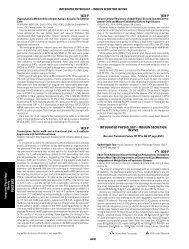Dissecting the Role of Glucocorticoids on Pancreas ... - Diabetes
Dissecting the Role of Glucocorticoids on Pancreas ... - Diabetes
Dissecting the Role of Glucocorticoids on Pancreas ... - Diabetes
You also want an ePaper? Increase the reach of your titles
YUMPU automatically turns print PDFs into web optimized ePapers that Google loves.
GLUCOCORTICOIDS AND PANCREAS DEVELOPMENT<br />
c<strong>on</strong>sequences <str<strong>on</strong>g>of</str<strong>on</strong>g> DEX treatment <strong>on</strong> exocrine and �<br />
endocrine cell differentiati<strong>on</strong> were analyzed by immunohistochemistry<br />
and RT-PCR. After 3 days <str<strong>on</strong>g>of</str<strong>on</strong>g> culture in<br />
<str<strong>on</strong>g>the</str<strong>on</strong>g> absence <str<strong>on</strong>g>of</str<strong>on</strong>g> DEX, all cells expressing insulin coexpressed<br />
Pdx-1 and were frequently found organized into<br />
small clusters, showing that <str<strong>on</strong>g>the</str<strong>on</strong>g> tissue had differentiated<br />
in culture. In striking c<strong>on</strong>trast, in DEX-treated buds,<br />
such �-cell clusters were absent and <str<strong>on</strong>g>the</str<strong>on</strong>g> number <str<strong>on</strong>g>of</str<strong>on</strong>g> cells<br />
coexpressing insulin and Pdx-1 was decreased, whereas<br />
<str<strong>on</strong>g>the</str<strong>on</strong>g> number <str<strong>on</strong>g>of</str<strong>on</strong>g> cells expressing <strong>on</strong>ly Pdx-1 remained<br />
unchanged (Fig. 2A). C<strong>on</strong>comitantly, DEX treatment led<br />
FIG. 1. GR is expressed in E15.5 rat pancreatic bud.<br />
A: GR (green) is detected in a subpopulati<strong>on</strong> <str<strong>on</strong>g>of</str<strong>on</strong>g><br />
epi<str<strong>on</strong>g>the</str<strong>on</strong>g>lial pan-cytokeratin (panCK)-positive cells<br />
(red). B: Few cells coexpressing insulin (red) and<br />
Pdx-1 (green) are found in E15.5 rat pancreatic<br />
buds. Scale bar � 25 �m.<br />
to a tw<str<strong>on</strong>g>of</str<strong>on</strong>g>old increase <str<strong>on</strong>g>of</str<strong>on</strong>g> amylase-c<strong>on</strong>taining cells, without<br />
altering <str<strong>on</strong>g>the</str<strong>on</strong>g> histological organizati<strong>on</strong> <str<strong>on</strong>g>of</str<strong>on</strong>g> <str<strong>on</strong>g>the</str<strong>on</strong>g> acini<br />
(Fig. 2B). Experiments <str<strong>on</strong>g>of</str<strong>on</strong>g> BrdU incorporati<strong>on</strong> showed<br />
that acinar cell proliferati<strong>on</strong> was decreased after 3 days<br />
<str<strong>on</strong>g>of</str<strong>on</strong>g> treatment with DEX (Fig. 2C) but not after 1 day, at<br />
which time more amylase-expressing cells were already<br />
observed (Fig. 2D). Taken toge<str<strong>on</strong>g>the</str<strong>on</strong>g>r, <str<strong>on</strong>g>the</str<strong>on</strong>g>se observati<strong>on</strong>s<br />
suggest that <str<strong>on</strong>g>the</str<strong>on</strong>g> increase in acinar cell area is a direct<br />
c<strong>on</strong>sequence <str<strong>on</strong>g>of</str<strong>on</strong>g> glucocorticoid-mediated stimulati<strong>on</strong> <str<strong>on</strong>g>of</str<strong>on</strong>g><br />
differentiati<strong>on</strong> and not acinar cell proliferati<strong>on</strong>. In both<br />
treated and untreated buds, �-cells as well as precursor<br />
FIG. 2. DEX favors in vitro pancreatic<br />
differentiati<strong>on</strong> into exocrine<br />
tissue and represses �-cell differentiati<strong>on</strong>.<br />
The effect <str<strong>on</strong>g>of</str<strong>on</strong>g> a 3-day<br />
treatment <str<strong>on</strong>g>of</str<strong>on</strong>g> E15.5 rat pancreatic<br />
buds with 10 �7 mol/l DEX <strong>on</strong> differentiati<strong>on</strong><br />
into �-cells or acinar<br />
cells is shown. A: Clusters <str<strong>on</strong>g>of</str<strong>on</strong>g> cells<br />
coexpressing insulin (red) and<br />
Pdx-1 (green) are abundant in c<strong>on</strong>trol<br />
buds (Co, C), but not in DEXtreated<br />
buds (DEX). Scale bar �<br />
25 �m. The number <str<strong>on</strong>g>of</str<strong>on</strong>g> differentiated<br />
�-cells coexpressing Pdx-1<br />
and insulin was decreased up<strong>on</strong><br />
DEX treatment, whereas <str<strong>on</strong>g>the</str<strong>on</strong>g> number<br />
<str<strong>on</strong>g>of</str<strong>on</strong>g> precursor cells expressing<br />
<strong>on</strong>ly Pdx-1 remained unchanged. B:<br />
Amylase cell area (brown) was increased<br />
tw<str<strong>on</strong>g>of</str<strong>on</strong>g>old in DEX-treated<br />
buds. Scale bar � 50 �m. C: BrdU �<br />
nuclei (red) were counted in amylase<br />
immunoreactive cells (green):<br />
acinar cell proliferati<strong>on</strong> was decreased<br />
in DEX-treated E15.5 embry<strong>on</strong>ic<br />
pancreas after 3 days. D:<br />
After 1 day <str<strong>on</strong>g>of</str<strong>on</strong>g> DEX treatment, acinar<br />
cell proliferati<strong>on</strong> was similar<br />
to that in untreated buds (Co), but<br />
amylase-expressing cell numbers<br />
were already increased. Scale<br />
bar � 50 �m. Results are expressed<br />
as means � SE; *P < 0.05<br />
compared with <str<strong>on</strong>g>the</str<strong>on</strong>g> untreated<br />
group.<br />
2324 DIABETES, VOL. 53, SEPTEMBER 2004
















